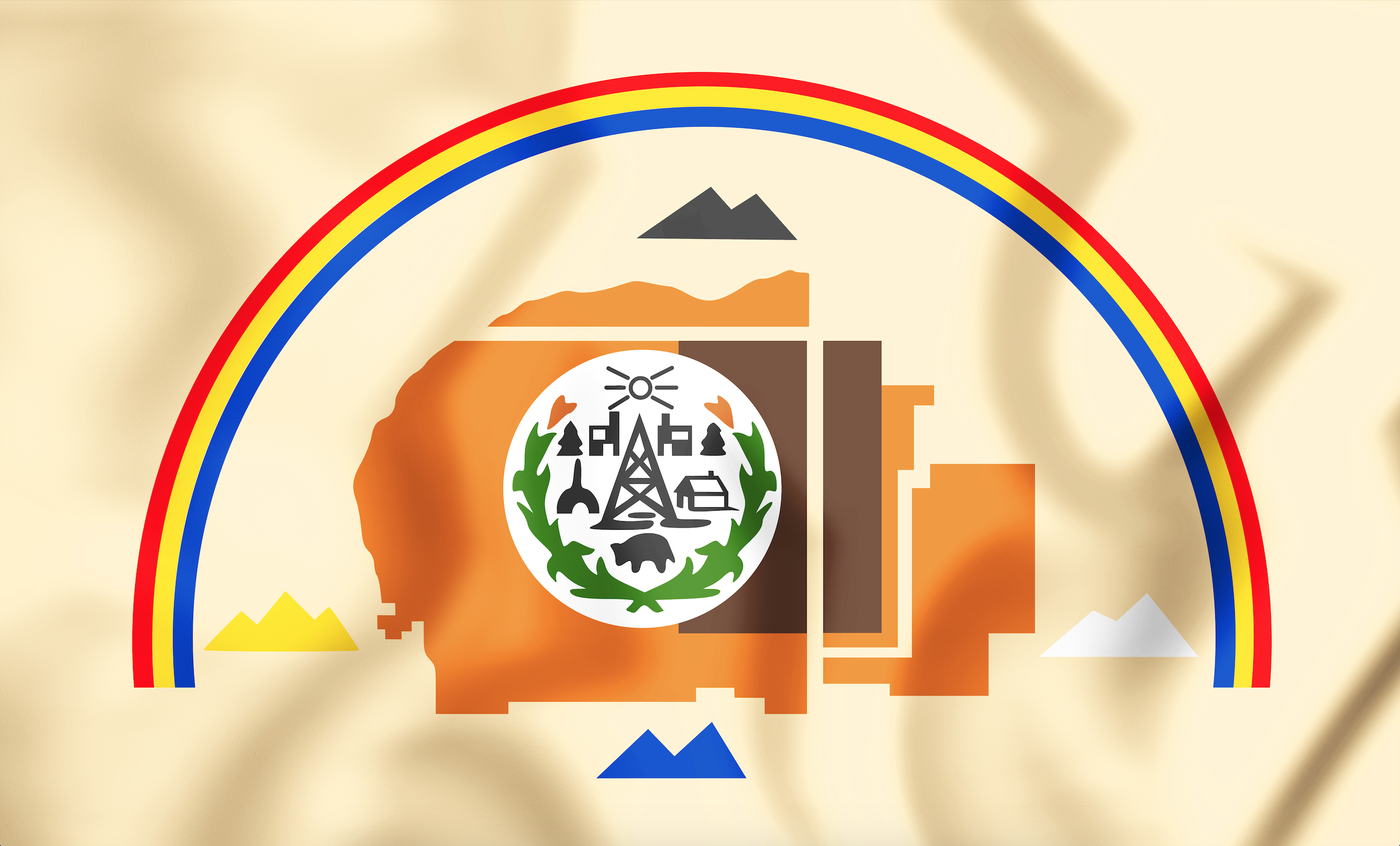
Embedded with ancient symbols of protection and references to traditional creation stories, the Navajo Nation flag has served as a proud representation of its people since 1968. Designed by student Jay Degroat, the drawing reflects the sacred art form of sand painting.
Mapping Diné Bikéyah
The main image in the center of the Navajo flag depicts a map of Navajoland. Referred to as Diné Bikéyah in the ancient language, the large light brown patch of the earth extends across the Four Corners region of Arizona, New Mexico, Colorado, and Utah. A copper line delineates this 27,000 square mile landmass that is home to more than 250,000 residents. Nestled inside this tan background is a darker brown rectangle to represent the smaller portion of land allocated to the Diné during the 1868 Treaty with the U.S. government.
Sacred Mountain Peaks
Four colorful mountains surround the ancestral homeland of the Navajo at each directional point. This space is the Dinétah, the sacred home of the gods. It is told in the creation story, the Emergence, that First Man placed four stones – jet, white shell, turquoise, and abalone – in each direction and then blew on each one four times to create a hogan. This humble, dome-shaped shelter birthed the world.
The meanings of these stones and their colors have become complex over time, linking the people to their creation, land, and future. The four sacred peaks and their colors are:
- Hesperus Peak (Dibé Ntsaa) represents the north—black. Located in the La Plata Mountains of southwestern Colorado, it is the highest sacred peak. Ruled by Jet Black Woman, the mountain controls the night.
- Blanca Peak (Tsisnaajini) represents the east—white. Although these sacred grounds in south-central Colorado are not part of the reservation, White-Shell Woman continues to rule over the eastern boundary, white represents the dawn as the sun rises.
- Mount Taylor (Tsoodzil) represents the south—blue. This southern mountain peak is nestled northeast of Grants, New Mexico. It is the domain of Turquoise Woman, who commands the daylight.
- San Francisco Peaks (Dook’o’oosliid) represents the west—yellow. These peaks are just outside of Flagstaff, Arizona. Abalone Woman oversees the setting sun at dusk as it disappears beyond these mountains.
Protection Under the Navajo Rainbow
A vivid rainbow in red, yellow, and blue arches over the sovereign land, never closing on the tribe’s independence. Folklore tells that the Navajo rainbow is a symbol of protection and the pathway of the Yeis. These healing holy spirits intercede between the Creator and humans and control the sun, moon, wind, and rain. A rainbow yei encircles most traditional sandpaintings to protect the image from evil spirits. Rainbows are also said to restore harmony and balance to a person’s hozho, their connection with the land.
The rainbow also calls to mind the graceful redstone arches formed during the Triassic and Jurassic periods across Navajoland. These mystical rock formations can be found at sacred sites, including Rainbow Bridge in Utah, and the park near the Navajo Nation Administration Center headquarters in Window Rock, Arizona.
The Great Seal Elements
In the center of the Navajo flag sits a white circle that incorporates many of the same elements featured in the original 1952 Great Seal that was designed by John Claw Jr. of Many Farms, Arizona.
- Sun: Hovering above the sacred symbols, the Sun Father brings light into a world of darkness. The Diné considers the rising and setting of the sun sacred times.
- Cornstalks: Two green cornstalks encircle the other symbols. As the primary food staple, corn represents fertility and sustenance. The tips are painted yellow to represent corn pollen, a sacred element used in healing rituals.
- Industry: Once a desolate section of land in the Southwest, the Navajo Nation relies heavily on sheep, sawmills, and oil for economic stability.
- Homes: A modern home and a traditional hogan flank the oil derrick. The entrance of the hogan faces east toward the rising sun.
Kachina House is dedicated to preserving the history, cultural traditions, and art of Native Americans. Our Arizona store carries a wide selection of pottery, jewelry, and other symbolic artifacts.


Our class is studying and reading about the Navajo Code Talkers of World War II. We read Chester Nez and the Unbreakable Code and are now reading Who Were the Navajo Code Talkers? We read a text from http://www.readworks and then colored the flag. Thank you for explaining the symbols on the Navajo flag. We will add that to our unit folder.
We are located in a very remote area, and our school, NaatsisAan community School, (Navajo Mountain, Utah) sure would like to have a Navajo Nation Flag and the Navajo Nation Seal to represent our Navajo Nation. Our address to our school is P. O. Box 10010, Tonalea, Arizona 86044. We stated study about out Navajo Nation and we sure would like to have this for our school. Thanks it would be appreciated by our study and staff.